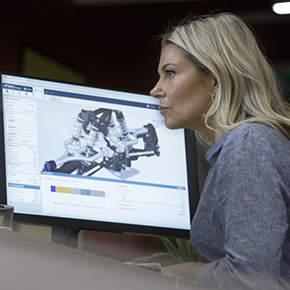Product Engineering: The Road to Achieving a $25K Electric Vehicle
Key Takeaways:
- Although electric vehicle (EV) sales continue to rise, the industry still faces several hurdles, not the least of which is affordability
- Product engineering teams can leverage aPriori’s AI-powered design and sourcing insights to meet the $25K affordability mark
The Full Article:
The International Energy Agency (IEA) notes in its Global EV Outlook 2024 that electric car sales continue to rise and could potentially reach approximately 17 million in 2024, or more than one in five cars sold worldwide. Although this is good news for the environment, it is not necessarily good news for EV manufacturers or consumers’ wallets.
Manufacturers must overcome hurdles such as the availability of battery materials like lithium and cobalt as well as rising energy prices and the cost of labor in China. Other impediments include material price volatility, inflation, fewer purchase incentives, tighter sustainability practices and regulations, more competition, and smaller profit margins.
All ultimately influence the sticker price of an EV. While some countries have successfully achieved EV affordability and overall adoption, others have not.
According to an Electric Vehicle Market Trends report, China continues to reign as the leader in EV adoption and affordability, with its market growing by 31% between January and May 2024 versus the same period in 2023. For instance, BYD is currently the leading EV maker. It recently introduced the Seagull (Dolphin Mini), with starting prices as low as $9,700 (69,800 yuan). In Brazil, it is called the Dolphin Mini and has a starting price of approximately $20,000 (99,800 BRL). It has been dubbed “Lamborghini mini” since former Lamborghini designer Wolfgang Egger led the product’s development. Moreover, the company is set on growing its annual sales to reach 3.6 million EVs this year. The move into South America underscores the company’s goal of 500,000 units sold internationally. It should be noted that EVs are highly subsidized by the Chinese government, which significantly contributes to Chinese EVs’ lower costs. BYD’s growth and successful adoption rates contrast sharply with those of the North American and European markets. Both continue to grapple with production rates and affordability. The North American (except for Mexico) and European markets grew just 5% and 4%, respectively. For instance, much of North America’s lackluster results were due, in part, to Tesla’s challenges (slower production rates) and the Biden Administration’s China EV and battery import tariffs. Tesla deliveries saw a year-over-year drop of 9%. Total revenue declined from $23.3 billion US to $21.3 billion US. Tesla also laid off 10% of the company’s global workforce. Additionally, there has been low consumer demand for EVs in North America due to high EV dealership prices and fewer available charging stations. However, Reuters notes a slight uptick in US EV sales in the second quarter of this year. But there is still much work to be done. How can North American and European automakers compete with China on production pace, affordability, and adoption? According to a Center for Automotive Research (CAR) whitepaper, the automotive industry supports the notion that mass adoption of EVs hinges on affordability. It concluded that EV “affordability” was $25,000, meaning half of US households could potentially afford such a vehicle. This “affordability” target is a big ask, given that the CAR whitepaper indicates that, in April of this year, the average new vehicle transaction price was $48,510, almost a 32% increase from the April 2019 average of $36,843. For an EV, the average price in April 2024 was even higher at $55,252. Multiple factors have affected this pricing, including: These factors impact automakers’ ability to produce expediently and affordably without compromising quality assurance. Even if these issues are addressed, customer expectations might differ and require further justification for an EV purchase. Without decisive consumer adoption, no amount of production retooling will ensure EV profitability or compete with lower-cost EVs like the ones China is producing. Although batteries are the leading contributor to an EV’s overall cost, they cannot be eliminated entirely – at least not in EVs as they are currently produced. However, there are other areas where EV costs can be reduced throughout the product development lifecycle. So, what can development teams do in the ideation and product design stages to ensure that an EV meets feasibility and functionality standards while enhancing user experience—all at the $25,000 affordability threshold? It boils down to having the right product engineering solution. It should be one that provides AI-powered design and sourcing insights and recommendations across the EV lifecycle, such as aPriori’s digital products. Although all stakeholders can benefit from these problem-solving tools, let’s explore two specific product development process areas: The law of supply and demand applies when sourcing. For example, small to medium aluminum castings are a common material/process in the automotive industry. These low-design complexity, relatively small size (40x10x10 inch range) parts are made in a high-pressured die casting (HPDC) process. HPDC is gaining greater prominence in automotive production, with companies like Tesla using it to make even larger, more complex vehicle parts. As cost pressures and production complexities continue to ramp up, the demand for new technologies and materials that can streamline production will persist. Higher-capacity batteries increase vehicle weight, which strains energy consumption and driving dynamics. Streamlining the body design and using aluminum castings can alleviate these issues. The die-casting market is expected to grow from approximately USD 76 billion to well over USD 100 billion by 2026. Greater supply and material accessibility leads to lower costs, faster time to market, and the ability to meet customers’ needs in terms of affordability. Manufacturers must ensure that designs are suitable for HPDC as well as cost-effective compared to other processes. AI-powered design insights allow manufacturers to consider and simulate alternative designs and processes necessary to this new architecture to determine feasibility before going too far down product development. It is essential that EV automakers have the ability to quickly identify those suppliers who can provide the materials and processes to make the parts necessary to keep up with the competition while remaining cost-efficient. It is essential that automakers foster strong supplier relationship management to reduce uncertainty about material/process pricing and availability. By working with suppliers in the early stages of the product lifecycle, automakers can strengthen relationships that provide key advantages. First, they can more efficiently vet suppliers to determine material availability and production capabilities. Second, should a supply chain issue arise, such as a specific supplier having an unexpected disruption, those automakers that have built a solid end-to-end supplier network will be less likely to face bottlenecks in their product lifecycle. Strong supplier relationships enable more cost-effective, fact-based negotiations regarding EV affordability. Software development solutions for product engineering services should enable Zero RFQs, removing the need for supply chain requests for quotes (RFQs). Instead, manufacturers work with designated suppliers who are willing to pre-negotiate material, labor, and overhead rates. As a result, costs are lowered and more consistent in the pre-production planning stages. What’s more, manufacturers can get EVs to market faster. Both ensure that affordability without sacrificing profitability is attainable. It underscores how crucial AI-powered design and sourcing insights are to the entire product development process. Let’s look at several examples of these insights in action: For example, constructing a digital twin of the factory floor can be used to uncover inefficiencies, predict and work to avoid machine malfunctions and downtimes, or run what-if scenarios for layouts and processes. Vehicle digital twins can be created from the concept phase straight through delivery. AI-powered design and sourcing insights and digital manufacturing simulations like aPriori’s can reduce iterations, accelerate development, lower costs, and potentially cut energy consumption. Dovetailing on the HPDC example in the above sourcing section, solutions like aPriori enable design engineers to determine if they, like Tesla, can push the boundaries on the size and complexity of aluminum castings in their EVs. AI-powered design insights can provide crucial manufacturability and cost feedback to determine feasibility. To complicate an already complicated EV scenario, rapid and ever-changing technologies can hamper time-to-market and affordability. EV models already on the market may require upgrades to components and materials as new and better versions emerge. Utilizing AI-powered design and sourcing insights can mitigate such issues early, quickly, and cost-effectively, ensuring that automakers can compete with affordable EVs. In traditional product development, product design cycles have been siloed. Design won’t necessarily work with sourcing or cost engineers in the early stages. As a result, the EV’s design requires more iterations and late-stage engineering change orders (ECOs), which further drive up costs and slow the product launch—all compromise affordability. However, this is the most optimal stage to save time and money by identifying and remediating manufacturability and cost issues.China Continues as the EV Adoption Leader
The EV Affordability Sweet Spot
How to Leverage Product Engineering to Achieve Affordability
Are Costs Eating Into Your Profits?
See how design for manufacturing (DFM) reduces costs, improves manufacturability, and lowers your carbon footprint








